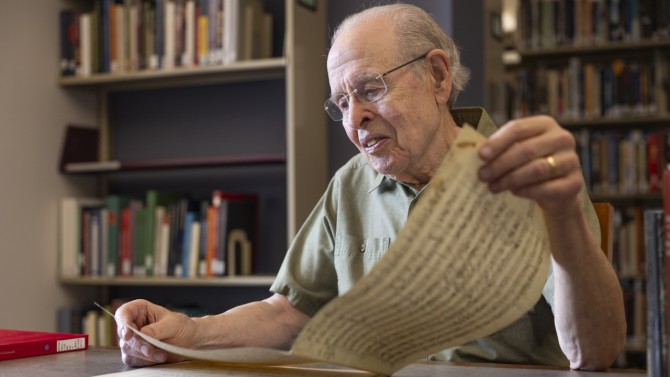Mozart was a musical prodigy, brilliant performer and a tireless, prolific composer.
If only he had been as disciplined about collecting and cataloguing his work.
In the years following Mozart's early death at the age of 35, people began working in earnest to put together a comprehensive chronology of Mozart's 600-plus compositions. The sleuthing, uncertainty, guesswork and revision continued for nearly two centuries.
Neal Zaslaw, the Herbert Gussman Professor of Music Emeritus, is the latest - and potentially the last - to assemble a so-called Köchel Catalog, named for Ludwig Ritter von Köchel, who created the first systematic inventory of Mozart's works.
Neal Zaslaw, the Herbert Gussman Professor of Music Emeritus in the College of Arts and Sciences, is the latest - and potentially the last - to assemble a so-called Köchel Catalog, named for Ludwig Ritter von Köchel, who created the first systematic inventory of Mozart's works, published in 1862.
Zaslaw's newly released "Köchel-Verzeichnis 2024" ("verzeichnis" is German for "list, catalog or directory") has been more than three decades in the making. The book's release will be celebrated Sept. 19 in Salzburg, Austria - Mozart's birthplace - and streamed live at 5 a.m. EST. It's a fitting capstone to the 85-year-old Zaslaw's career as one of the world's leading Mozart authorities, one who was once dubbed "Mr. Mozart" by the New York Times for organizing the 1991-92 Mozart Bicentennial at Lincoln Center.
"My goal was to finish it before I died," he said. "And I faked everybody out and did it."
'A maze of manuscripts and editions'
As the son of a professional musician, Mozart began performing, touring and composing at an age when most children are learning the alphabet and basic arithmetic. He wrote steadily and abundantly, and over the years he had many patrons, commissions, tours, publishers and score copyists. When he died in Vienna in 1791 during a flu epidemic, he'd left behind "a maze of manuscripts and editions scattered across Western Europe," according to Zaslaw.
"He became a sort of a cultural hero, and people were fighting over his legacy and trying to get their hands on his music," Zaslaw said. "Some of his music had been published in two or three cities because there were no international copyright laws then, but plenty of his other music had never been published. A lot of works had gone missing. And there were forgeries, because when unscrupulous publishers acquired music by little-known composers, which was unlikely to sell under their names, they knew it could sell under Mozart's name."
Ludwig Ritter von Köchel was a scholar, royal tutor, amateur musician and "Mozart worshiper" who devoted much of his life to researching the maestro. He built upon previous, partial catalogs to assemble the bulk of Mozart's works and established a double system of organizing them: chronologically by composition date and indexed by genre, i.e., symphonies, operas, sonatas, etc.
By doing so, Zaslaw said, Köchel created the first systematic reckoning of a composer's works, which served as the model for cataloging the music of other composers and made him a pioneer in the field of musicology.
But the Köchel catalog still contained gaps and errors, and its author furiously collected notes for a follow-up but died before its completion. His publisher, Breitkopf and Härtel, produced a second edition in 1905, and others followed in the ensuing decades, some of them authorized, others much contested, which only increased the confusion, as did the fact that Europe was riven by a pair of world wars.
"In the '50s and '60s, Europe was still in chaos. During World War II, many sources had changed hands, been hidden for safekeeping or destroyed. Collectors of and dealers in Mozart's manuscripts had fled Europe with their treasures, settling in England, Argentina, Canada and the United States," Zaslaw said. "In addition, a considerable number of Mozart's manuscripts taken from the Prussian State Library in Berlin had disappeared behind the Iron Curtain. The Russians weren't telling where they were."
In 1992, Zaslaw was giving a talk in Basel, Switzerland, when he received a call from Breitkopf and Härtel - the world's oldest music publisher, headquartered in the German city of Wiesbaden - asking if one of its editors could come down and meet with him.
"Their editor took me to lunch and asked if I wanted to make a new edition of the catalog," Zaslaw said. "And like a fool, I grinned and said, 'It sounds like fun.'"







